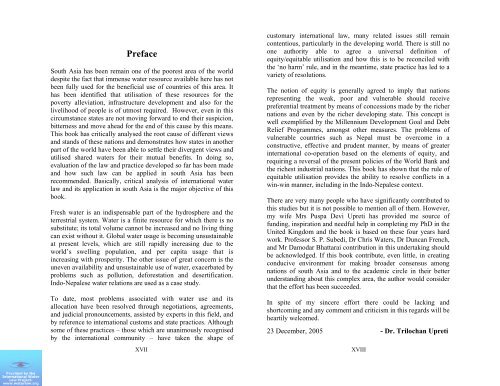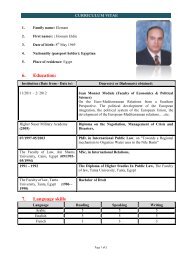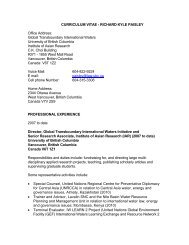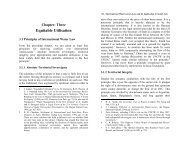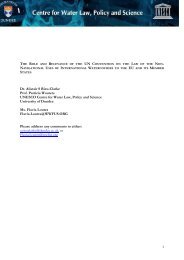Upreti, Trilochan, International Watercourses Law and Its Application ...
Upreti, Trilochan, International Watercourses Law and Its Application ...
Upreti, Trilochan, International Watercourses Law and Its Application ...
Create successful ePaper yourself
Turn your PDF publications into a flip-book with our unique Google optimized e-Paper software.
PrefaceSouth Asia has been remain one of the poorest area of the worlddespite the fact that immense water resource available here has notbeen fully used for the beneficial use of countries of this area. Ithas been identified that utilisation of these resources for thepoverty alleviation, infrastructure development <strong>and</strong> also for thelivelihood of people is of utmost required. However, even in thiscircumstance states are not moving forward to end their suspicion,bitterness <strong>and</strong> move ahead for the end of this cause by this means.This book has critically analysed the root cause of different views<strong>and</strong> st<strong>and</strong>s of these nations <strong>and</strong> demonstrates how states in anotherpart of the world have been able to settle their divergent views <strong>and</strong>utilised shared waters for their mutual benefits. In doing so,evaluation of the law <strong>and</strong> practice developed so far has been made<strong>and</strong> how such law can be applied in south Asia has beenrecommended. Basically, critical analysis of international waterlaw <strong>and</strong> its application in south Asia is the major objective of thisbook.Fresh water is an indispensable part of the hydrosphere <strong>and</strong> theterrestrial system. Water is a finite resource for which there is nosubstitute; its total volume cannot be increased <strong>and</strong> no living thingcan exist without it. Global water usage is becoming unsustainableat present levels, which are still rapidly increasing due to theworld’s swelling population, <strong>and</strong> per capita usage that isincreasing with prosperity. The other issue of great concern is theuneven availability <strong>and</strong> unsustainable use of water, exacerbated byproblems such as pollution, deforestation <strong>and</strong> desertification.Indo-Nepalese water relations are used as a case study.To date, most problems associated with water use <strong>and</strong> itsallocation have been resolved through negotiations, agreements,<strong>and</strong> judicial pronouncements, assisted by experts in this field, <strong>and</strong>by reference to international customs <strong>and</strong> state practices. Althoughsome of these practices – those which are unanimously recognisedby the international community – have taken the shape ofcustomary international law, many related issues still remaincontentious, particularly in the developing world. There is still noone authority able to agree a universal definition ofequity/equitable utilisation <strong>and</strong> how this is to be reconciled withthe ‘no harm’ rule, <strong>and</strong> in the meantime, state practice has led to avariety of resolutions.The notion of equity is generally agreed to imply that nationsrepresenting the weak, poor <strong>and</strong> vulnerable should receivepreferential treatment by means of concessions made by the richernations <strong>and</strong> even by the richer developing state. This concept iswell exemplified by the Millennium Development Goal <strong>and</strong> DebtRelief Programmes, amongst other measures. The problems ofvulnerable countries such as Nepal must be overcome in aconstructive, effective <strong>and</strong> prudent manner, by means of greaterinternational co-operation based on the elements of equity, <strong>and</strong>requiring a reversal of the present policies of the World Bank <strong>and</strong>the richest industrial nations. This book has shown that the rule ofequitable utilisation provides the ability to resolve conflicts in awin-win manner, including in the Indo-Nepalese context.There are very many people who have significantly contributed tothis studies but it is not possible to mention all of them. However,my wife Mrs Puspa Devi <strong>Upreti</strong> has provided me source offunding, inspiration <strong>and</strong> needful help in completing my PhD in theUnited Kingdom <strong>and</strong> the book is based on these four years hardwork. Professor S. P. Subedi, Dr Chris Waters, Dr Duncan French,<strong>and</strong> Mr Damodar Bhattarai contribution in this undertaking shouldbe acknowledged. If this book contribute, even little, in creatingconducive environment for making broader consensus amongnations of south Asia <strong>and</strong> to the academic circle in their betterunderst<strong>and</strong>ing about this complex area, the author would considerthat the effort has been succeeded.In spite of my sincere effort there could be lacking <strong>and</strong>shortcoming <strong>and</strong> any comment <strong>and</strong> criticism in this regards will beheartily welcomed.23 December, 2005 - Dr. <strong>Trilochan</strong> <strong>Upreti</strong>XVII XVIII


